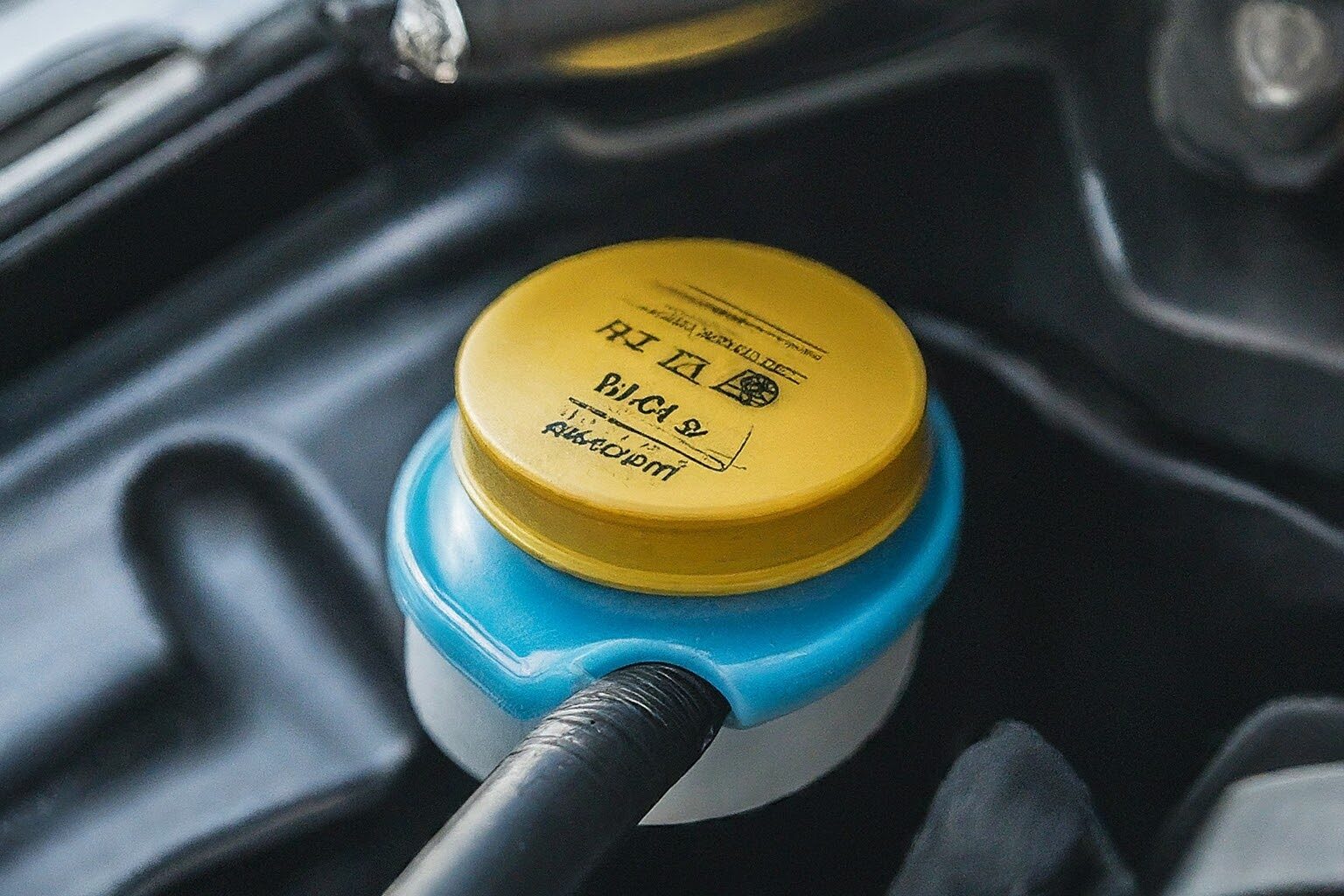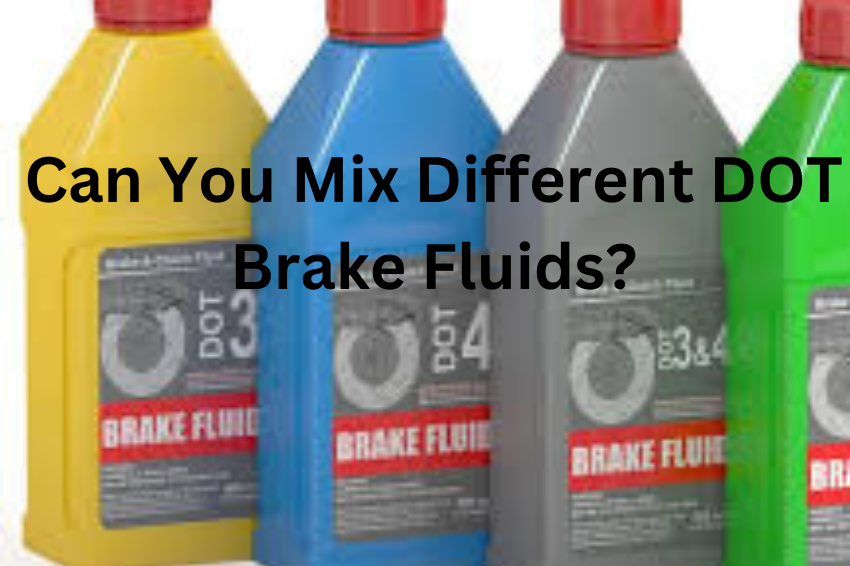“Mixing DOT fluids can be done cautiously, but only within compatible classifications (DOT 3 & 4 are glycol-based and okay to mix). Using incompatible fluids (like DOT 5 with others) can damage your braking system. Always check your car’s manual for the recommended DOT type to ensure optimal performance and safety.”
Your car’s braking system relies on hydraulic pressure for smooth and safe stopping.
Brake fluid transmits this pressure from the brake pedal to the calipers, creating the clamping force that stops your wheels.
Different DOT classifications (DOT 3 vs DOT 4 for example) indicate the fluid’s boiling point, an important factor for maintaining braking performance.

Mixing DOT fluids may seem like a quick solution if you need a top-up in a bit, but there are safety considerations to keep in mind:
- Compatibility: DOT 3, DOT 4, and DOT 5.1 are all glycol-based and generally compatible with each other.
However, DOT 5 is silicone-based and not interchangeable with others.
Mixing incompatible fluids can lead to corrosion within the braking system, compromising its performance and potentially causing brake failure.
This is why checking for DOT fluid compatibility before mixing is required.
- Boiling Point: Each DOT classification has minimum dry and wet boiling points.
The dry boiling point refers to the fluid’s performance under new and unused conditions.
The wet boiling point mirrors the fluid’s performance after absorbing moisture over time, which is inevitable due to the hygroscopic nature of brake fluid.
Mixing fluids can alter the overall boiling point, potentially causing the fluid to boil under heavy braking situations like racing or mountain driving.
This can lead to a dangerous loss of braking power, commonly referred to as brake fade.
Here’s how to ensure safe mixing practices:
- Consult your car’s manual first. The manufacturer specifies the recommended DOT type for your specific vehicle. This will ensure optimal performance and avoid compatibility issues.
- Unsure? Opt for a Full Flush. Flushing the entire brake system removes all the old fluid and guarantees compatibility with the new DOT type you choose. This is the safest option, especially if you’re unsure about the existing fluid.
- Emergency Top-Up: In an absolute emergency, a small amount of compatible DOT fluid (like DOT 3 or 4) for topping up might be okay. However, prioritize a full flush at your earliest convenience to ensure complete compatibility and optimal braking performance.
Here’s a helpful video on DOT Brake Fluid Compatibility:
Which Brake Fluid Is Right For Your Car?
“The ideal DOT fluid depends on your car’s manual recommendations and driving style. DOT 3 and DOT 4 are common choices, with DOT 4 offering higher boiling points for performance driving. DOT 5 is silicone-based, not interchangeable with others, and is typically used in racing applications.”
Here’s a breakdown of the most common DOT fluids to help you guide this choice:
- DOT 3: This widely used and affordable option has minimum dry and wet boiling points (DOT 3 boiling point) of 401°F (205°C) and 284°F (140°C) respectively.
DOT 3 is suitable for most everyday driving conditions like commuting or errands.
However, it might not be ideal for:
- Performance driving: Activities like track days or aggressive mountain driving generate higher heat, potentially exceeding DOT 3’s boiling point and causing brake fade.
- Heavy towing: Towing puts extra stress on your braking system. A higher boiling point fluid like DOT 4 can be beneficial in these situations.
- DOT 4: Offering superior boiling points compared to DOT 3 (446°F/230°C dry and 311°F/155°C wet), DOT 4 is a popular choice for:
- Performance driving: The higher boiling points help resist brake fade during heavy braking maneuvers.
- Sportier vehicles: Many sports cars come equipped with DOT 4 from the factory due to their increased performance capabilities.
- DOT 5: This silicone-based fluid boasts the highest boiling points (500°F/260°C dry and 356°F/180°C wet).
However, DOT 5 is not compatible with glycol-based fluids (DOT 3 & 4) and requires a complete system flush before use.
Due to its properties, DOT 5 is typically used in:
- Racing applications: Where extreme heat generation is a constant factor.
- Vehicles in storage: Because DOT 5 is less hygroscopic (absorbs less moisture) than glycol-based fluids, it can be an option for cars that sit unused for extended periods.
With that said the best DOT fluid for your car depends on two key factors:
- Manufacturer Recommendation: Your car’s manual specifies the recommended DOT type for optimal performance and compatibility with your braking system.
It’s important to prioritize this recommendation to avoid compromising safety.
You can often find this information in the owner’s manual under the “recommended fluids and lubricants” section.
- Driving Habits: Consider your typical driving conditions.
If you engage in activities like:
- Performance driving (track days, aggressive mountain driving)
- Frequent towing
- Heavy-duty hauling
- Off-roading You might benefit from a higher boiling point fluid like DOT 4.
For everyday driving, DOT 3 is usually sufficient.
Can You Top Up The Brake Fluid? Mixing New And Old
“Topping up with the same DOT type you already have is usually yes. Mixing compatible DOT fluids (like DOT 3 & 4) may be acceptable in a bit, but a full flush is generally better for optimal performance. Always refer to your car’s manual for specific guidance.”
However, there are some key things to consider, especially regarding mixing new and old fluid.
- Topping Up with the Same DOT Type: If your car’s manual recommends a specific DOT type (e.g., DOT 3) and the existing fluid appears clean and light-colored, topping up with the same DOT type is usually acceptable.
Yet, this is a temporary solution, and a full flush is recommended at a later service interval.
- Mixing Compatible DOT Fluids: In an emergency, mixing compatible DOT fluids (like DOT 3 and DOT 4, which are both glycol-based) might be okay for a short period.
It’s essential to prioritize a full brake fluid flush as soon as possible.
Mixing fluids can alter the overall boiling point of the fluid, potentially reducing braking performance.
Here’s how to approach topping up brake fluid safely:
- Consult your car’s manual: This is important to determine the recommended DOT type for your vehicle and identify the location of the brake fluid reservoir.
- Identify the existing fluid type: The reservoir cap indicates the DOT classification. If unsure, consult a mechanic.
- Use clean tools and only DOT-approved fluid. Avoid contamination by using clean tools and cloths.
- Don’t overfill the reservoir. Refer to the markings on the reservoir for the proper level.
- Prioritize a full flush at your earliest convenience. This ensures optimal performance and removes any potential contaminants from the system.
Below is a video by Nulon on how you can check, and top up brake fluid:
Warning Signs Your Brake Fluid Needs A Flush
“Signs of a needed brake fluid flush include a spongy brake pedal, low fluid level (without leaks), and the fluid is dark or cloudy. Regular flushes (as per manufacturer recommendations) ensure optimal braking performance and safety.”
Here’s how to identify if your brake fluid needs a flush:
- Spongy Brake Pedal: A firm brake pedal feel (see image) is essential for confident and controlled braking.
If your brake pedal feels soft or spongy when pressed, it could indicate air in the brake system or degraded brake fluid.
A flush can help remove air bubbles and restore a firm pedal feel.
- Low Brake Fluid Level (Without Leaks): While a low brake fluid level might seem like a simple top-up situation, it could signify a leak in the system.
If you haven’t noticed any leaks and your fluid level is constantly dropping, it could be a sign of worn brake pads or internal wear within the calipers.
In such cases, a brake system inspection alongside a flush might be necessary.
- Dark or Cloudy Brake Fluid: Fresh brake fluid is typically clear or light amber.
If your brake fluid appears dark, brown, or cloudy, it tells of contamination or excessive moisture absorption.
This can seriously reduce the boiling point of the fluid, leading to potential brake fade during heavy braking situations.
A flush will remove the old, contaminated fluid and replace it with fresh, high-performing fluid.
Even if you haven’t experienced any of the warning signs mentioned above, regular brake fluid flushes are essential for maintaining optimal braking performance and safety.
Most car manufacturers recommend specific service intervals for brake fluid flushes.
These intervals can vary depending on factors like your driving habits, car type, and climatic conditions.
Refer to your car’s manual for the recommended flush interval for your specific vehicle.
Here are some additional benefits of regular brake fluid flushes:
- Prevents Corrosion: Moisture in brake fluid can lead to corrosion within the braking system’s components. Regular flushes remove moisture and help prevent this corrosion.
- Improved Braking Response: Fresh brake fluid ensures a more responsive and predictable braking feel, enhancing driving confidence.
- Extends Brake System Life: Regular maintenance, including brake fluid flushes, helps maintain the health of your braking system and can potentially extend the lifespan of its components.
Note: If you notice any warning signs like a spongy brake pedal or dark brake fluid, don’t hesitate to consult a qualified mechanic for a professional inspection and potential brake fluid flush.
